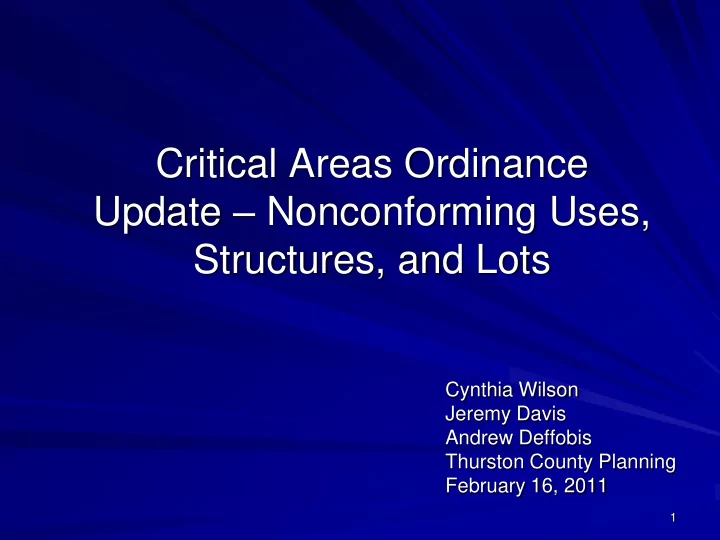

Critical Areas Ordinance Update – Nonconforming Uses, Structures, and Lots Cynthia Wilson Jeremy Davis Andrew Deffobis Thurston County Planning February 16, 2011 1
CAO Update – Status Work continues on draft ordinance, BAS report Several chapters have been released to Planning Commission, website 24.01 General Provisions 24.03 Definitions 24.30 Wetlands 24.50 Nonconforming Structures, Lots, Uses 24.55 Subdivision 24.60 Signs and Fencing 24.70 Sureties 24.90 Emergency Authorization 24.91 Amendments 24.92 Enforcement, Violations and Penalties 2
24.50 Nonconforming Uses, Structures and Lots Establishes provisions for changes to existing uses, structures and lots affected by critical areas Generally allows the following: – alteration and maintenance within footprint – expansion of conforming portions, vertical expansion of nonconforming – rebuilding of destroyed structures; discretionary replacement 3
General Caveats Nonconforming = Legally existing, nonconforming use, structure or lot Differences between critical areas – Standards for frequently flooded areas are different, based on hazard presented and Chapter 14.38 TCC – Unless otherwise specified, in this presentation wetlands are used as an example, standards shown represent “all other critical areas” Presentation provides overview; detailed standards are in Chapter 24.50 TCC Nonconforming uses, structures and lots subject to all applicable County regulations 4
Maintenance and Alteration Maintenance and repair: “…routine care and upkeep of a structure, development, land use or activity.” Alteration: change to, addition to, or modification of existing use or structure beyond routine repair and maintenance but not amounting to complete replacement. – Includes activities up to 50% fair market value. – Alterations totaling > 50% fair market value are considered discretionary replacement under chapter 24.50 TCC 5
Maintenance and Alteration Nonconforming structures can be maintained/altered within existing footprint – includes attached decks, porches and patios In floodway, both maintenance and alteration include activities totaling up to 50% of structure’s fair market value – Exception: Work done to comply with existing health, sanitary or safety codes or to structures identified as historic buildings 6
Maintenance and Alteration All development is subject to all applicable County standards. 7
Expansion - General Conforming portions of structures may be expanded (expansion may not enter critical area/buffer) Nonconforming portions may be expanded vertically, subject to standards In floodway, only vertical expansion allowed Cost of expansion may total up to 50% structure’s fair market value A 500 sq. ft. expansion of impervious surface allowed in riparian habitat areas/pond buffers under some circumstances 8
Expansion - General All development is subject to all applicable County standards. 9
Expansion – Riparian/Pond All development is subject to all applicable County standards. 10
Replacing a Destroyed Structure (Applies to structures “damaged or destroyed by accident, fire, explosion, act of God, or public enemy”; destruction = damage > 50% fair market value) Structures may be rebuilt to the same degree of nonconformity (e.g. same square footage, footprint) In frequently flooded areas, replacement subject to chapter 14.38 TCC (e.g. elevate structure) – Cannot rebuild in floodway 11
Replacing a Destroyed Structure All development is subject to all applicable County standards. 12
Discretionary Replacement Prohibited within frequently flooded areas (e.g. floodplain/flood elevation of record) , 100-year channel migration hazard area, high groundwater NDZ, SMP jurisdiction Other critical areas/buffers – relocate outside if possible If relocated, original building site must be restored 13
Discretionary Replacement All development is subject to all applicable County standards. 14
Existing Lots - Generally Structures and appurtenances must locate outside critical areas/buffers if possible – Exception: seismic, volcanic, mine hazards No structures within 100-year floodplain/flood of record No new construction shall create a public safety risk Restoration required to offset impacts 15
Existing Lots – Generally (cont.) When < 5,000 sq. ft. outside critical area/buffer, may encroach on outer 50% of buffer providing: – No adverse impact on species of concern – Footprint inside cannot be expanded in future – Minimum native tree removal, must revegetate 16
Existing Lots – High Groundwater Hazards New res. structures must have lowest floor, materials, and systems susceptible to flood damage located at least 2 ft. above the base flood elevation – New non-res. construction shall be elevated at least 2 ft above the base flood elevation Structures must be located where they are least likely to be flooded 17
Existing Lot – High Groundwater & General All development is subject to all All development is subject to all applicable applicable County standards. County standards. 18
Existing Lots – Floodplain All structures must locate outside floodplain/base flood elevation Nonresidential structures/appurtenances must locate outside high groundwater flood hazard area No new construction shall create public safety risk 19
Existing Lot – Channel Migration Hazard Areas When < 5,000 sq. ft. outside, may encroach providing: – Minimal encroachment necessary – Structures sited where impacts are least likely – No adverse impact on species of concern – Footprint inside may not be expanded in future – Minimum native veg. removal, must revegetate 20
Existing Lot – CMZ & Floodplains All development is subject to all applicable County standards. 21
General Caveats - Reminder Nonconforming = Legally existing, nonconforming use, structure or lot Differences between critical areas – Standards for frequently flooded areas are different, based on hazard presented and Chapter 14.38 TCC – Unless otherwise specified, in this presentation wetlands are used as an example, standards shown represent “all other critical areas” Presentation provides overview; detailed standards are in Chapter 24.50 TCC Nonconforming uses, structures and lots subject to all applicable County regulations 22
Next Steps Release remaining draft chapters, including: – Administrative Procedures – Critical Area chapters (CARAs, Geo. Hazards, Frequently Flooded Areas, FWHCAs) – Special Reports – Critical Area Permit – Critical Area Tracts and Easements – Reasonable Use Exception Continue Planning Commission discussions 23
Questions? www.thurstonplanning.org 24
Recommend
More recommend